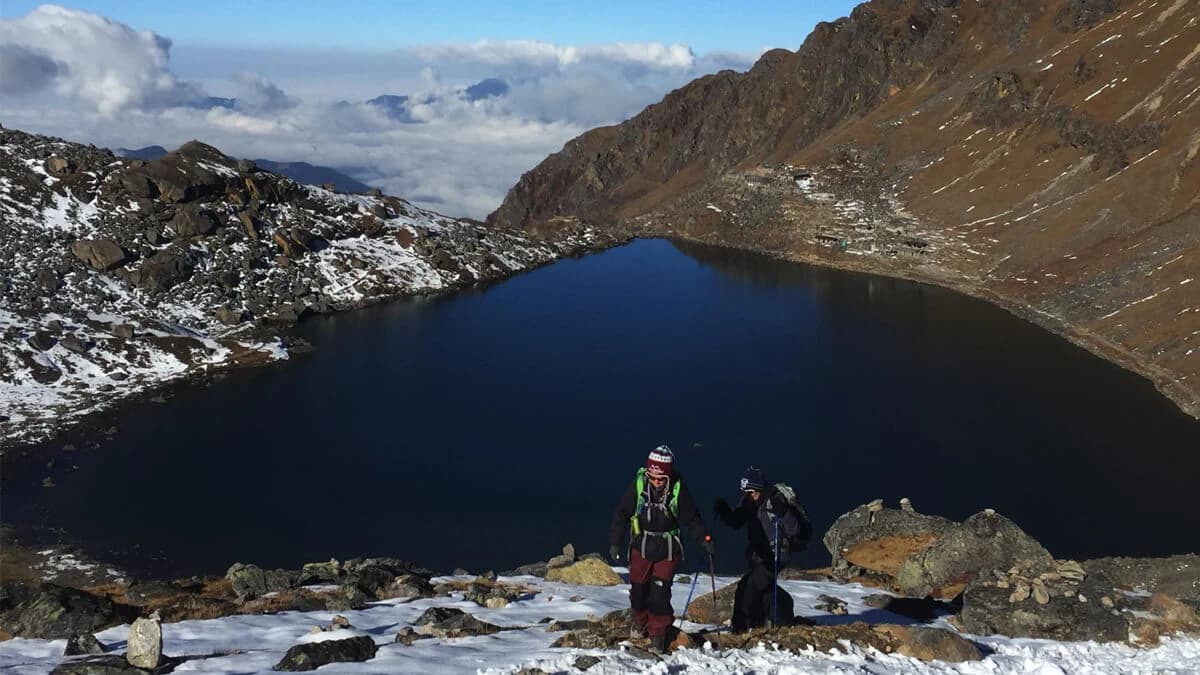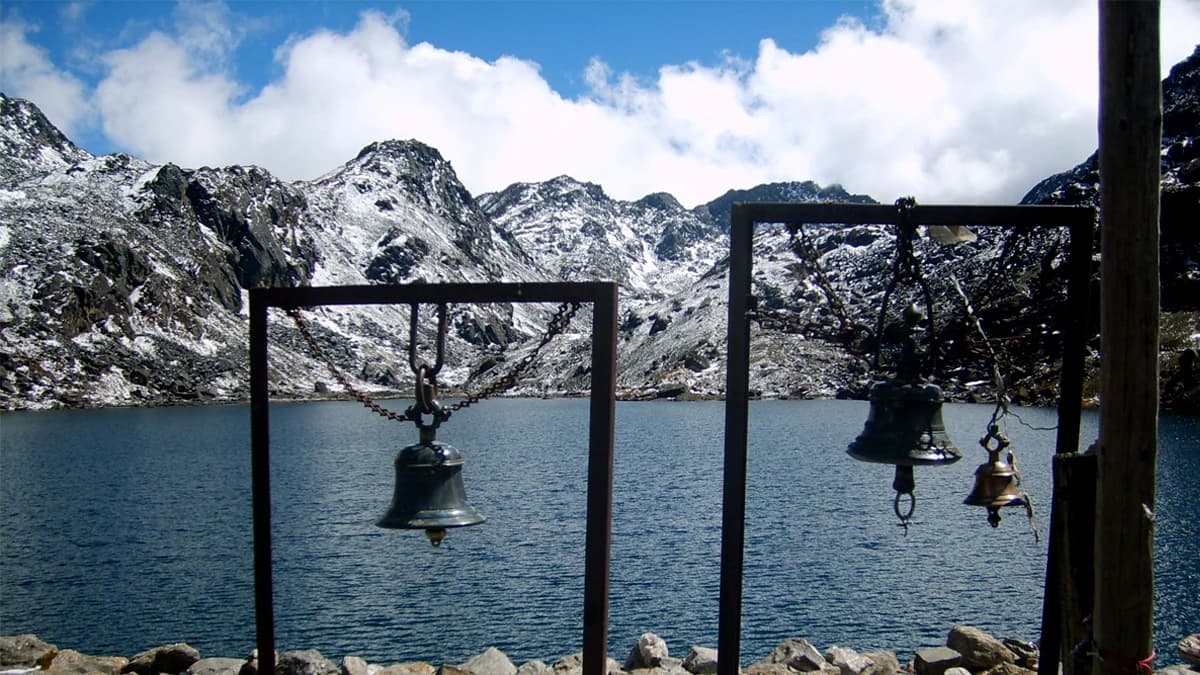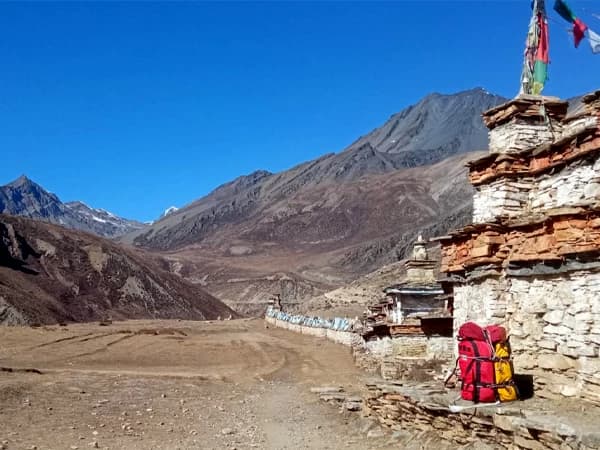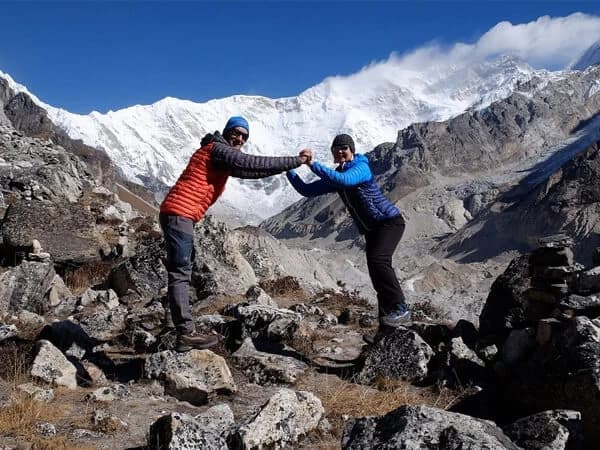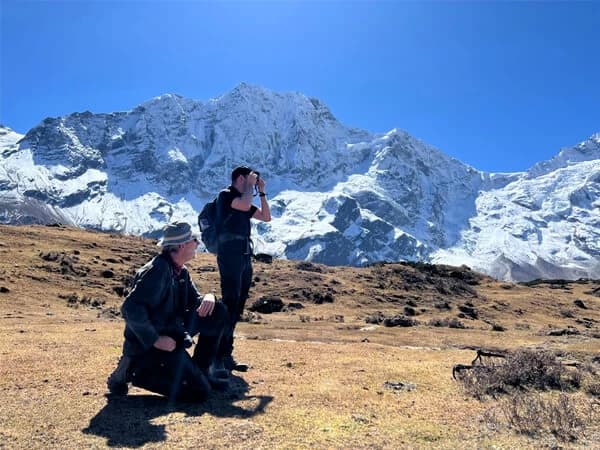Explore the motivational Langtang village and spiritual Kyanjin Gompa, and gain insight into the cultural and religious significance of the Gosaikunda Lake at 3640 m, and cross the Laurebina Pass (4165 meters). Pass through the dense woodland of the thriving red rhododendrons, with an insight into rare fauna, Tibetan villages, heavenly glaciers, waterfalls, roaring rivers, and the iconic panorama of the Langtang range, along with other highest surrounding peaks.
This 13-day Langtang Gosaikunda Trek package leads you to notable spots that sit within the Langtang region, offering a wild off-beaten trail adventure that reaches the highest elevation of Tsergo Ri at 4984 meters, and is perfect for beginners, being well customized by professional expert teams.
Langtang Gosaikunda Trekking Overview
The Langtang Gosainkunda Trek is a perfect fusion of adventure, culture, and heavenly insights into the rich biodiversity and ecosystem, which unveils the preserved beauty of Nepal's first Himalayan national park - Langtang National Park. It is a combined trek of the iconic Langtang Valley and the sacred Gosaikunda Lake, and crosses the thrilling Lauribina pass at 4610 meters. Despite being a high-altitude adventure, our itinerary is carefully tailored with a gradual ascent, which can be smoothly navigated by beginners or the family with kids, with the assistance of an experienced, licensed, and medically equipped trekking guide, safely and smoothly.
Culturally rich Langtang Gosainkunda Trekking is mostly inhabited by the Tamang ethnic groups, who follow the ancient Buddhist spirituality, and the proof resides in the monasteries, mani walls, chortens, and the simple livelihood of the locals, which you get to insight during the 13-day trek. As it is a tea house trek, the main highlight stands out to be the cultural exploration of Tamang and Sherpa locals residing here for ages, and the day exploration, at the spiritual hub of Kyanjin Gompa, and a visit to the yak cheese factory nearby, which contributes 80% of the economy of the locals.
Before reaching here, the trek navigates through famous local hamlets such as Syabrubesi, Bamboo, Lama Hotel, Ghoda Tabela, Langtang village, and the blooming red rhododendron and pine forest, along with the roaring sound of the Langtang River, and the possibility of encountering some rare wildlife such as the elusive red panda, musk deer, snow leopard, and the Himalayan migrating birds.
The trekkers have multiple choices from Kyanjin Gompa for day hiking, such as ascending to Kyanjin Ri, Tsergo Ri, or a day trip to Langshisa Kharka; nonetheless, our itinerary leads you to the Kyanjin Ri or Tserko Ri viewpoints, as per your choice and pace of trekking level. One day, hiking to Langshisha Kharka – the border of Nepal and China through Langshisha Valley is highly recommended if you have an extra 2 days.
As this Langtang Valley with Gosaikunda Trek is combined, keep all good memories in mind and continue trekking to Gosainkunda and the Helambu region. Ascending from Syabru Village to Chandanbari and Lauribina could be a little difficult. A panoramic eyewitness from the Lauribina Pass and Gosainkunda Lake exploration will be a once-in-a-lifetime experience, a famous pilgrimage site for Hindus, from Nepal and India, that shows the 360-degree vista of the surrounding glaciers and iconic Langtang range, Shishapangma, Ganesh Himal, Yala Peak, Jugal Himal massif, and many others that sit here.
After the venture experience of only trekking past the Lauribina Pass in the Langtang and Gosaikunda Lake Trek, the trail descends to Sundarijal by passing Thade, Kutumsang village, Chauki Bhanjyang, Mangeni Goth, and Chisapani, which is densely settled by Sherpa locals.
Hence, if you are someone who loves to wander around pristine nature, has a keen interest in learning about the new distinct cultures back in the days of the Tibetans, and wants to witness the panoramic views of mountains and distinct landscapes, with a relatively less crowded trailhead, being easily accessible from the capital city - Kathmandu, then this trek fits pefectly for you.
Get your trekking rucksack ready with equipment for this adventurous trail and join Destination Himalaya Treks. Our team is standing by to make your Nepal visit unforgettable for a lifetime by ticking off one of the best trekking routes in the Himalayas.
Highlights
- Explore the Tamang ethical culture and religion in the Himalayas
- Get a lively experience of the Tibetan Buddhist religion and the local people's daily lifestyle
- Relish yourself in the authenticity and empowering Langtang Village
- Unravel the spiritual and religious Gosaikunda Lake - a high altitude freshwater lake, amid the pristine region that soars at an elevation of 4380 meters
- Stroll around Kyanjing Gompa village and the Yak cheese factory- a Swiss-like factory
- Traverse through Langtang Valley and Langshisha Valley, holding deep spiritual significance
- Ascend to the Kyanjing Ri Viewpoint and Tsergo Ri Viewpoint
- Cross the challenging Lauribina Pass, pushing off your limits that stand at 4610 m./15124 ft.
Langtang Gosaikunda Trek route
Our 13-day Langtang Gosaikunda Trek route covers the first half of the standard Langtang Trekking itinerary, and then ascends to the highest elevation of this trek, Tsergo Ri at 4984 meters. Then, touches the route of the Gosaikunda Lake route, from Syabrubesi village, from where the trekking route actually begins after taking a drive to Syabrubesi village (1470 m) from Kathmandu (1360 m).
This itinerary begins with a 6-7 hour drive to Syabrubesi, just following the general standard route, then proceeds to the hike further, following the pathway, through Lama Hotel (2340 m) and Langtang village (3450 meters), via woodlands, dotted with rhododendron forest, and the roaring Langtang River, witha chirping sounds of himalayan birds, and gazing over the cultural insights of Tibetan tamang culture and terraced fields. Afterwards, the trek reaches the iconic Kyanjin Gompa at 3870 meters, popularly known as the spiritual hub, with a visit to the famous yak cheese factory.
During 1 day acclimatization at Kyanjin Gompa, we will basically take an ascent to either Kyanjin Ri or Tsergo Ri, whatever you prefer, and then take a descent to Lama Hotel and Syabru village on the following two days.
Finally, the route touches the Gosaikunda Lake Trek route from Shin Gompa (4210 meters), and visits another ultimate destination, the holy Gosaikunda Lake at 3640 meters, showing the reflection of the Himalayan peaks, and the nearby Saraswati Kunda, Bhairabkunda, and other associated holy lakes.
Following the trailhead, it crosses over the Lauribina Pass, which soars at an elevation of 4610 meters, which is the most challenging section of this overall trip, and then takes a downhill walk to Tharepati, Kutumsag (2230 m), and Chisapani (1350 m). Finally, this trek reaches the Sundarijal and ends with a drive back to Kathmandu via private vehicle on the 13th day.
Simple, Beginner, and Family Friendly Adventure
This Langtang Valley and Gosaikunda Trek marks one of the easiest yet thrilling adventures, which leads you through off-beaten and remote trekking trails, exploring the untamed beauty of the Langtang region. Being effortlessly accessible, from Kathmandu, with just a few hours drive from the capital city to Syabrubesi, the starting point of this trek, and being just completed within 13 days, covering two best treks in Nepal, no matter whether you are a family with kids, or a solo trekker, hiking alone, this trek is safe and filled with thrills and cultural exploration.
Even though this trek leads you through the deeper forested areas, and one of the passes over 4000 meters, which is Lauribina Pass, with the assistance of our experienced licensed guide, you will find no challenges in navigation. However, prior preparation for to trail through 5-6 hour walking trail remains crucial, and essential packings must be considered beforehand.
Despite that, the routes are well facilitated with basic amenities, and you are showered with great hospitality and mountain insights, which a beginner and your kids can definitely learn from, and get introduced to the world of the Himalayas. In short, this trip falls under an easily moderate trek, which anyone can venture out on, with our perfectly customized itinerary; hence, it's a perfect shot for you if you want something simple, easy, and safe to undertake, in a short period of time.
Rewarding Panoramic Views of Mountains
The major highlight of this 13-day Langtang Gosaikunda Trek stands out to be the unmatched view of the snowcapped Himalayan peaks and the landscapes themselves. Lasting just for two weeks, this odyssey promises to reward you with the 360-degree surrounding mountain vista in each stride, that too, via a distinct perspective, that you can cherish forever. Throughout the journey, the exceptional insight of thundering iconic peaks such as Ganesh Himal (7422 m), Naya Kanga (5848 m), Langtang Lirung at 7345 meters, Kimsung (6782 m), Shishapangma (8028 m), along with Dorje Lhakpa (6967 m), Loenpo Gang at 6978 m, and Yala Peak at 5512 m, that stretches to the fish lens views of Yansa Tsenji with other Himalayan glaciers, will befriend you in step.
Where the first half of the trail is bloomed with red rhododendrons, pines, and oaks, with a possibility of encountering some of the rare wild fauna, such as langur monkeys, musk deer, and Himalayan bear, that have been preserved within the Langtang National Park, which is considered Nepal's first national park, covering 1710 sq. kilometers.
While moving to the higher elevation above 3000 meters, the great panoramic views of the Jugal Himal range, Dorje Lhakpa, and many others, start to unravel their majestic view in a 360-degree vista. Meanwhile, on the other hand, the highest altitude holy Lake, Gosaikunda Lake at 4300 meters, within this park, showcases the holy and cultural significance, with nearby other spiritual lakes.
Ascending to Kyanjin Ri and Tsergo Ri (4984 m)
During an acclimatization (excursion day), we will basically take a summit to the highest elevation of this trek, which is Tsergo Ri, perched at the height of 4984 meters, with the rewarding panoramic insight of the Langtang range along with other peaks, including the famous summit mountain - Yala Peak. The ascent to this highest altitude is the challenging section of this trip, which takes almost 6 to 7 hours of time, just for the uphill walk, and 2-3 hrs to return to the Kyanjin Gompa. Even though the ascent is a bit strenuous, via rugged terrains and heavy winds, the prospect of the heavenly glaciers, the alpine valley that stretches to the Tiber, will surely leave you speechless.
On the other hand, if such an ascent sounds wild and hectic, then we provide you with another option, to take an uphill to Kyanjin Ri (4773 meters), which unravels the sweeping view of Langtang valley and the whole Kyanjin region.
Trek to Gosaikunda Lake: Where Beauty and Pilgrimage Insight Meet
Perched at 4380 meters (14338 in feet), Gosaikunda Lake is the highest altitude alpine lake, which is considered a holy pilgrimage site, which is said to be the abode of Lord Shiva and Parbati (his wife), as per Hindu beliefs, covering 13.8 hectares of surface area, which is insightfully captivating and carries a religious significance. Among 108 lakes, the holy Gosaikunda Lake is the most popular one, with other revered lakes of Bhairab Kunda, Naga Kunda, Surya Kunda, Saraswati Kunda, residing between the Langtang Valley and Helambu regions.
Every year, thousands of pilgrims visit the holy lake to take a bath during the festival of Janai Purnima, in August, which falls within the Autumn season. If your itinerary fits within this span of the year, then the great Hindu belief and the religious aspect of the locals will surely mark a place in your heart; nonetheless, if not the autumn season, the surrounding Himalayan peaks, which reflect in the lake, and the cultural encounters with Tamang locals, and other indigenous communities, during the trek, provides a distinct insight of this iconic spot.
Cross the Laurebina Pass (4681 m)
Laurebina Pass, which soars at an altitude of 4681 meters, that located over the Gosaikunda and borders the Helambu region, which is reached by passing through the thriving forest of rhododendrons, Tamang Tibetan villages, and attains a height, which offers the almighty view of the world's eighth highest peak of Mount Manaslu at 8163 meters, with the surrounding Himalayan peaks. The crossing over to Laurebina Pass is done after exploring the Gosaikunda Lakes, and takes a descent to Tharepani, with an insight into the Tibetan villages, and Tibetan dotted landscapes, with mani walls, chortens, prayer flags, and monasteries in between.
Distinct Cultural Insights of the Tamang locals
Trekking in Langtang Gosainkunda is renowned for its phenomenal natural beauty as well as its highlighted Langtang culture, people, and religion. The area is mainly inhabited by the largest ethnic group of Nepal, who are known as Tamang, who believe in Tibetan Buddhism and follow their culture and religion accordingly. Their daily language to each other is Tamang, which is influenced by the Tibetan language.
Though Hinduism is a significant presence in Gosainkunda, as Gosainkunda Lake is one of the holiest Hindu sites of Nepal. The pilgrims from all over Nepal come here for prayers and perform purification rituals. After crossing Lauribina Pass, across the Helambu region, we explore the Sherpa people who mostly believe in Buddhism and Buddhist culture, but a different way of culture than the Khumbu region of eastern Nepal.
Langtang and Gosaikunda Trek Cost for 2025 and 2026
The combined trip to Langtang Gosaikunda Trekking costs start from USD 795 and go up to USD 975 per head, which highly depends on the number of hikers that your group actually holds, and the service that you are looking forward to opting for. Meanwhile, our standard price for a single elusive private trip, tends to be USD 975 per person, whereas, as higher the number of the trekkers of your group gets increases, the lower the costing gets.
Our package covers every required essential, such as required trekking permits, experienced licensed guides with English speaking fluency, and a porter, with other basic amenities including standard 3 times meals, accommodations, and transportation fare as well. Here is a breakdown of the costing based on the number of hikers, in each group, crafted for the years 2025 and 2026:
| No. of Hikers | Standard Price |
| 1-1 | 975 per head |
| 2-2 | 850 per head |
| 3-4 | 799 per head |
| 5-6 | 650 per head |
| 7-12 | 599 per head |
Unique Complimentary Benefits from Destination Himalaya Treks
- 2 nights free staycation at our hotel Bihani - a standard hotel in the bustling city of Thamel, Kathmandu
- Pre-briefing before confirming your booking via WhatsApp, Zoom, Viber, Skype, or direct call, or mail, whatever is feasible to you
- Free Airport pick-up and drop-off at the hotel
- Customizing the itinerary as per the budget and time duration
- Private exclusive tour with an experienced local guide with an experience 10+ years of experience
- 24/7 hour communication at +977 9851016814 or email at info@destinationhimalayatreks.com
- Additional gear like a Trekking T-shirt, a Cap, and a Sleeping Bag (must be returned after the trip)
- Basic First Aid Kit - oximeter (to check pulse rate) and water purification tablet (to purify the water en route)
- 5% special discount to the family group (must be over 4)
